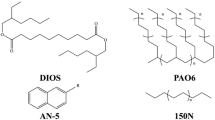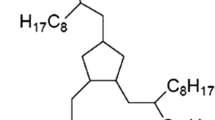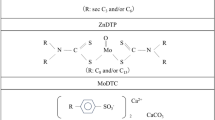Abstract
In this work, a series of experiments on tribofilm formation of sulfur- and phosphorus-free organic molybdenum additive (SPFM) on bearing steel surfaces have been performed in a ZrO2 ball-on-steel plate tester lubricated by gas-to-liquid (GTL), di-2-ethylhexylsebacate (Ester), or polyalphaolefin (PAO) synthetic oils under different temperature and external voltage conditions. The synergy effect of SPFM with 2,5-dimercapto-1,3,4-thiadiazole derivative (DMTD) and zinc dithiophosphate (ZDDP) additives has also been investigated. The results reveal that SPFM additive plays a major role in reduction of friction and wear by formation of MoOx tribofilm on steel surface lubricated with either GTL or PAO oil samples, which can be enhanced by an externally applied voltage. S element provided by DMTD additive can react with Mo element in SPFM to form MoS2, which also contributes friction reduction. Comparing with GTL and PAO base oils, the Ester oil is less effective in the tribofilm formation because of its low solubility for the additives. Higher temperatures (at 60 °C, 100 °C or 140 °C) and an initial running-in are beneficial to the tribofilm formation. A three-step mechanism, hydrolysis of SPFM, adsorption of the MoO42− anions, and tribochemical reactions at the rubbing surface, is proposed to explain the observed voltage-assisted tribofilm formation results.
Graphical Abstract




















Similar content being viewed by others
Change history
12 September 2023
A Correction to this paper has been published: https://doi.org/10.1007/s11249-023-01782-9
References
Wen, S., Huang, P.: Principles of Tribology. Tsinghua University Press, Beijing (2017)
Taylor, R.I., Morgan, N., Mainwaring, R., et al.: How much mixed/boundary friction is there in an engine — and where is it? Proceedings of the Institution of Mechanical Engineers, Part J: Journal of Engineering Tribology 234(10), 1563–1579 (2020)
Taylor, R.I.: Energy efficiency, emissions, tribological challenges and fluid requirements of electrified passenger car vehicles. Lubricants 9(7), 66 (2021)
Hu, J., Wei, X., Dai, G., et al.: Tribological behaviors and mechanism of sulfur- and phosphorus-free organic molybdate ester with zinc dialkyldithiophosphate. Tribol. Int. 41(6), 549–555 (2008)
Akin, M., Tekin, N.: Preparation of additive package for gear lubricants and determination of tribological properties. Pet. Chem. 56(2), 175–180 (2016)
Hu, J.Q., Wei, X.Y., Zong, Z.M.: Study on tribological and corrosion inhibiting properties of thiadiazole derivative as lubricant grease additive. Indus Lubricat Tribol 58(6), 320–323 (2006)
Wang, J., Wang, J., Li, C., et al.: A study of 2,5-dimercapto-1,3,4-thiadiazole derivatives as multifunctional additives in water-based hydraulic fluid. Indust LubricatTribol 66(3), 402–410 (2014)
Huai, W., Chen, X., Lu, F., et al.: Tribological properties of sulfur- and phosphorus-free organic molybdenum compound as additive in oil. Tribol. Int. 141, 105944 (2020)
Wang, S.S., Maheswari, S.P., Tung, S.C.: The nature of electrochemical reactions between several zinc organodithiophosphate antiwear additives and cast iron surfaces. Tribol. Trans. 32(1), 91–99 (1989)
Tung, S.C., Wang, S.S.: In-situ electro-charging for friction reduction and wear resistant film formation. Tribol. Trans. 34(4), 479–488 (1991)
Xu, X., Spikes, H.: Study of zinc dialkyldithiophosphate in di-ethylhexyl sebacate using electrochemical techniques. Tribol. Lett. 25(2), 141–148 (2007)
Cao, H., Meng, Y.: Electrochemical effect on boundary lubrication of ZDDP additive blended in propylene carbonate / diethyl succinate. Tribol. Int. 126, 229–239 (2018)
Meng Y, Liu C. Spatiotemporal manipulation of boundary lubrication by electro-charging and electrochemical methods: Superlubricity 2nd Edition. Erdermir A, Martin J M, Lou J Elsevier, 2020, 499–516
Sauerbrey, G.: Verwendung von Schwingquarzen zur Wägung dünner Schichten und zur Mikrowägung. Z. Phys. 155, 206–222 (1959)
Liu, C., Friedman, O., Meng, Y., et al.: CuS nanoparticle additives for enhanced ester lubricant performance. ACS Applied Nano Materials 1(12), 7060–7065 (2018)
Liu, C., Meng, Y., Tian, Y.: Potential-controlled boundary lubrication using MoS2 additives in diethyl succinate. Tribol. Lett. (2020). https://doi.org/10.1007/s11249-020-01313-w
Morina, A., Neville, A., Priest, M., et al.: ZDDP and MoDTC interactions in boundary lubrication—The effect of temperature and ZDDP/MoDTC ratio. Tribol. Int. 39(12), 1545–1557 (2006)
Izutsu, K.: Electrochemistry in Nonaqueous Solutions. WILEY-VCH verlag GmbH & Co. KGaA, Weinheim (2009)
Rounds, F.G.: Some factors affecting the decomposition of three commercial zinc organodithiophosphates. ASLE transactions 18(2), 79–89 (1975)
Spedding, H., Watkins, R.C.: The antiwear mechanism of zddp’s Part I. Tribol. Int. 15(1), 9–12 (1982)
Watkins, R.C.: The antiwear mechanism of zddp’s Part II. Tribol. Int. 15(1), 13–15 (1982)
Yin, Z., Masound, K., Bancroft, G.M., et al.: Chemical characterization of antiwear films generated on steel by zinc dialkyl dithiophosphate using X-ray absorption spectroscopy. Tribol. Int. 26(6), 383–388 (1993)
Tomala, A.M., Ripoll, M.R., Michalczewski, R.: Tribological synergy between classical ZDDP and innovative MoS2 and MoO3 nanotube additives at elevated temperatures. Proc. Est. Acad. Sci. 68(2), 178 (2019)
Hu, J., Wei, X., Dai, G., et al.: Synergistic antioxidation of organic molybdenum complex with dithiocarbamate antioxidant evaluated by differential scanning calorimetry and thin film micro oxidation test. Thermochim. Acta 453(1), 21–26 (2007)
Kajdas, C.: About an anionic-radical concept of the lubrication mechanism of alcohols. Wear 116(2), 167–180 (1987)
Acknowledgements
This work has been financially supported by Tsinghua (SVM)—Shell Joint Research Center for Clean Mobility under the Work Order No. CW 299060, National Natural Science Foundation of China (Grant No. 51961145303, Grant No. 5191101008, Grant No. 5210050195.), and China Postdoctoral Science Foundation (Grant No. 2021TQ0175). Authors thank Professor Chenhui Zhang of Tsinghua University for providing the SPFM additive and Jiping Zhang from Tianjin Research Institute for Advanced Equipment, Tsinghua University, for the composition analysis of additives.
Author information
Authors and Affiliations
Corresponding author
Ethics declarations
Conflict of interest
There are no conflicts to declare.
Additional information
Publisher's Note
Springer Nature remains neutral with regard to jurisdictional claims in published maps and institutional affiliations.
Rights and permissions
Springer Nature or its licensor (e.g. a society or other partner) holds exclusive rights to this article under a publishing agreement with the author(s) or other rightsholder(s); author self-archiving of the accepted manuscript version of this article is solely governed by the terms of such publishing agreement and applicable law.
About this article
Cite this article
Liu, C., Li, W., Ouyang, C. et al. Voltage-Assisted Tribofilm Formation of Sulfur- and Phosphorus-Free Organic Molybdenum Additive on Bearing Steel Surfaces in Industrial Base Oils. Tribol Lett 70, 19 (2022). https://doi.org/10.1007/s11249-022-01562-x
Received:
Accepted:
Published:
DOI: https://doi.org/10.1007/s11249-022-01562-x




